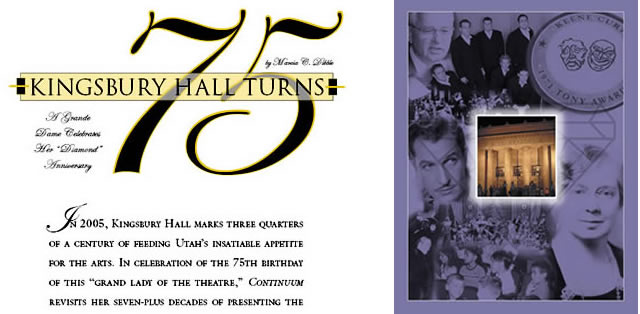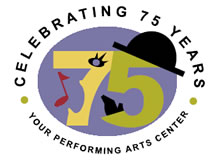
Vol. 14 No. 3 |
Winter 2004-05 |

The completion of Kingsbury Hall in 1930 brought the campus and the community together in a new home for the arts, and for decades after, Kingsbury became the place to see performers of national and international stature.
"This was the nucleus for performing arts in Salt Lake City," says Greg Geilmann ex’77, director of the hall since 1995.
"The contribution that this institution has made to the performing arts in this valley is hard to quantify."
Major personalities began making appearances at Kingsbury from its earliest years. Poet Robert Frost lectured in 1940; in 1948, Norwegian explorer Thor Heyerdahl initiated his first American tour at the hall. In 1959 both poet Carl Sandburg and Sen. John F. Kennedy (in his presidential campaign circuit) spoke to overfl owing crowds. And in 1960, former First Lady Eleanor Roosevelt graced Kingsbury as the featured speaker at convocation, followed only months later by Rev. Martin Luther King Jr.
Beginning in 1955, Kingsbury also became home to the valley’s must-see Christmas-season production of The Nutcracker. "The Nutcracker has always been an important part of the cultural fabric of Salt Lake," says Geilmann. "But it used to be a tradition that everybody came to Kingsbury Hall."
With the advent of the University "Prestige Series" in 1967, Kingsbury began hosting annual productions featuring top-tier artists such as Isaac Stern, Itzhak Perlman, Carlos Montoya, Marcel Marceau and others.
And beginning in 1968, Kingsbury became home to many of the Intermountain West’s premier performing arts organizations, including the Utah Symphony, the Utah Civic Ballet (which became Ballet West), the Utah Opera Company, Utah Repertory Dance Theatre and the Ririe-Woodbury Dance Company.
But, some unique scenarios—and complications—resulted from the hall’s then-limited floor plan.
"The stage was so small there were many times we had to have someone catch us as we jumped off stage, so we wouldn’t hit the wall," says Valerie Horton, a former dancer with Utah Civic Ballet.
"In order to get enough space onstage in Act II of The Nutcracker," recounts Geilmann, "Clara’s Throne was actually outside the building, in a shed. One performance, there was a major thaw of ice and ‘Clara’ was drenched with freezing water. Act II is 45 minutes long, and I think this happened about 25 minutes in, but she stayed up there… She could have caught pneumonia!"
"There was enough water that it was like a waterfall," says Horton, now an administrative assistant in the U’s ballet department, who was onstage during the Clara drenching. "But dancers never let on something is wrong. They just gut it out."
In the early 1970s, with the nation’s 200th anniversary approaching, Utah’s Bicentennial Commission wanted a new multipurpose hall downtown and chose to renovate the Capitol Theatre. When the theatre reopened in 1978, Kingsbury’s resident tenants relocated downtown, in search of ambience, parking and a bigger stage.
 |
|
“We
always try to take the arts out into the community.” |
Then, in 1980, budget cuts eliminated Kingsbury’s "Prestige Series." University President James C. Fletcher (1964-71) had been focused on making the U a Research I institution, and by the time President David Gardner (1973-83) arrived, emphasis had shifted to the sciences. "That was a double thrashing for Kingsbury Hall," says Geilmann.
Still, Kingsbury continued to play host to some striking scenes.
"I remember one time in the early ’90s, the Nelson twins [rockers Nelson, sons of actor-pop idol Rick Nelson] were performing here," recalls Lynda Christensen BS’70, events and operations manager of Kingsbury from 1991 until 2003, who remains active on the board. "And when people think of groupies, they tend to think of them as being older teenagers or young adults. But these were little girls, about 7, 8 and 9 years old, with huge bouquets of roses for the Nelson twins. I’d never seen anything like it. "
In 1993, Kingsbury was asked if it could host the Capitol Theatre’s resident companies for two months while Phantom of the Opera was in town. At about the same time, President Art Smith conducted a seminar in Kingsbury, coming away dissatisfied with its condition and wanting something done. "The planets all lined up," says Geilmann, and in May of 1994, Kingsbury closed its doors and spent the next 18 months undergoing a $14 million overhaul.
"Everyone at that time said, ‘It can’t be done, it won’t be ready,’" recalls Christensen.
"But the U answered the call," Geilmann continues. "And Kingsbury Hall was touted to be the overflow facility for bookings that could not be accommodated at the Capitol Theatre."
Kingsbury reopened with a grand gala on March 25, 1996, unveiling a completely revamped presenting hall, including a motorized orchestra pit that can be reset to add audience seating or rise to stage level to extend the front end of the performing area.
For the first three or four years after the refurbished hall opened, most of Kingsbury’s scheduling went to space rental, in which outside promoters rent the hall to mount their productions.
"But we knew we wanted to bring back a presenting program and that we had to find additional funding, so we added a development office in 2000," Geilmann explains. "In 2001 we started presenting our own schedule, and 2002 was our first subscription season."
With the new series, "Kingsbury Hall Presents," the theatre has again been able to offer a handpicked slate of performances. Highlights of the 2002-03 season included memorable visits by avant-garde groups such as Ballet Hispanico and the Swiss mime troupe Mummenschanz.
"We always try to take the arts out into the community," notes Geilmann, "so when Ballet Hispanico came, we organized a lecture-demonstration at Centro Civico Mexicano of a ‘Latin Social Dance,’ where people come to learn Latin dance steps—in this case from the visiting professional dancers themselves." "It was just amazing, and I think this was our big break- through in realizing the talent and potential for this kind of outreach," says Josh Paulsen BS’04, Kingsbury’s marketing and communications manager. "KRCL broadcast live because it was during their Hispanic Night, and we had more people show up than we could accommodate—kids, people from every race and religion; it was very multicultural." "You couldn’t even get to the punch table, it was so crowded," Christensen jokes.
When Mummenschanz performed in March 2003, Kingsbury arranged a special performance for students, including many from the Utah schools for the deaf.
 "We
filled the auditorium with those students, and they watched this performance
that doesn’t have any sound, and it was just perfect," recalls
Paulsen. "We had signers, and it was an amazing company… Many
kids said, ‘This is the first time I’ve been to a theatre,
and this is the neatest thing I’ve ever seen!’"
"We
filled the auditorium with those students, and they watched this performance
that doesn’t have any sound, and it was just perfect," recalls
Paulsen. "We had signers, and it was an amazing company… Many
kids said, ‘This is the first time I’ve been to a theatre,
and this is the neatest thing I’ve ever seen!’"
When Wynton Marsalis made an appearance during the 2003-04 season, Kingsbury organized a jazz social with the collaboration of the University Park Marriott.
"We invited students from the School of Music to come and play," comments Paulsen. "Wynton came with three or four bandmates and jammed with the students. And Mark Eaton [former basketball player with the Utah Jazz] showed up, too."
"It also turns out Wynton has a great interest in basketball and had been following the Jazz, so they really hit it off and had a great evening," Geilmann adds. "And even when Wynton took a break, the students kept playing. He’d go back to the bar but keep his trumpet out," continues Paulsen. "And if the students got going on an improvisation that he liked, he’d jump in playing right from the bar."
In October, early on in Kingsbury’s 2004-05 presenting season, the hall hosted the renowned Paul Taylor Dance Company, which was celebrating its own 50th anniversary. Kingsbury Hall was PTDC’s only venue in Utah for its "50 Years-50 States" tour, an honor Geilmann is understandably proud of.
"We have become the de facto dance presenter in Salt Lake," says Geilmann. "There are two great modern dance companies, a great ballet company, and a great pop company —Odyssey Dance Theatre—all here, based in Salt Lake City, but we are the presenter that brings in dance. And we’re very, very pleased to play that role."
"We had a ‘dirt show’ one time," notes technical director Randy Rasmussen, chuckling and shaking his head as he acknowledges yet another of the unique challenges Kingsbury has encountered in its quest for excellence.
"For a Ron Brown Dance performance, we had to sift dirt to make it clear of any foreign matter. So the student presenters, who brought in the dance company, bought potting soil and had all these people backstage sifting dirt. And then we hung it in the air and it rained dirt."
Early in November, Kingsbury scored a coup in hosting The Ten Tenors, an Australian group that performs Broadway pop and classic opera standards.
Comments Geilmann: "I was very relieved to be able to get them, because after this, they’re going to be playing big arenas. But Kingsbury Hall has gotten a lot of those scoops. Dave Matthews performed at Kingsbury Hall, and you’ll never see him in a small venue now. We’ve been able to nab a number of performers who were right on the cusp and get them just before they became huge stars."
 Also
in November, the top student dancers from the University’s own nationally
acclaimed Utah Ballet commemorated Kingsbury’s 75th anniversary
in their annual performance with a beautiful piece titled "Tribute."
Also
in November, the top student dancers from the University’s own nationally
acclaimed Utah Ballet commemorated Kingsbury’s 75th anniversary
in their annual performance with a beautiful piece titled "Tribute."
"It’s part of our mission to showcase University of Utah performing arts students," says Geilmann. "We think it’s so vital to these young semi-professional dancers that are aspiring to get into professional companies to be able to perform on a professional stage of the size and prestige of Kingsbury Hall. And we are always, always so impressed with the quality of work that they bring to Kingsbury every year."
Not everyone is aware that the University of Utah was actually the first university to offer a degree in ballet—and that the dancers in the program performed at Kingsbury, under the guidance of "Mr. C," Willam Christensen, "the father of American ballet in the West," who started the University’s ballet department. "Now," says Geilmann, "the University’s Utah Ballet is a semi-reincarnation of the earlier Utah Civic Ballet. It’s really come full circle."
As has Kingsbury.
—Marcia C. Dibble is Continuum assistant editor.